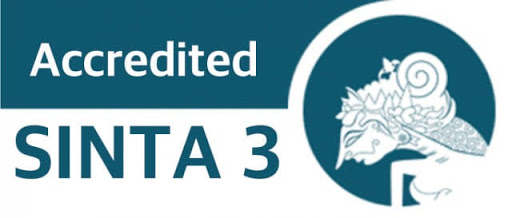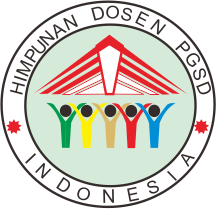ICT-BASED MATHEMATICS LEARNING MODULE: STUDENTS’ RESPONSES IN LEARNING PROCESS
Abstract
Keywords
Full Text:
PDF (Bahasa Indonesia)References
Akhmadan, W. (2017). Pengembangan Bahan Ajar Materi Garis dan Sudut Menggunakan Macromedia Flash dan Moodle Kelas VII Sekolah Menengah Pertama. Jurnal Gantang, 2 (1), 27-40
Association for Educational Communications and Technology (1977). The definition of educational technology. Washington, D.C.: Association for Educational Communications and Technology.
Alhaddad, I. (2016). Perkembangan Pembelajaran Matematika Masa Kini. Delta-Pi: Jurnal Matematika Dan Pendidikan Matematika, 4(1), 13-26
Alzaber & Amelia, S. (2014). Hubungan indeks prestasi kumulatif dengan kecemasan matematika mahasiswa pendidikan matematika FKIP UIR. Jurnal aksiomatik program studi pendidikan matematika FKIP UIR, 1 (2).
Dewi, I., & Lisiani, S. (2015). Upaya Meningkatkan Kreativitas Matematis Siswa Sekolah Menengah Pertama Negeri 5 Terbuka Medan dengan Menggunakan Modul Model Learning cycle. Jurnal Didaktik Matematika, 2(1), 11-20
Hartinah DS, S. d. (2013). Sikap Guru Taman Kanak-Kanak Terhadap Pembelajaran Matematika. Jurnal Ilmu Pendidikan, 19 (1), 50-55.
Hernawan, A. H., Permasih, H., & Dewi, L. (2012). Pengembangan Bahan Ajar. Direktorat UPI: Bandung.
Istikomah, E., & Wahyuni, A. (2018). Student’s Mathematics Anxiety on the Use of Technology in Mathematics Learning. Journal of Research and Advances in Mathematics Education (JREMathEdu), 3(2), 69-77
Depdiknas. (2008). Teknik Penyusunan Modul. Jakarta: Direktorat Jenderal Manajemen Pendidikan Dasar dan Menengah
Maharani, A. (2017). Pengembangan Bahan Ajar Matematika Berbasis Macromedia Flash Materi Operasi Bilangan Real SMK Teknologi & Rekayasa. Jurnal Teori dan Riset Matematika (Teorema). 2(1), 1-10.
Mustamid, D. H. (2015). Pengaruh Efektivitas Multimedia Pembelajaran Macromedia Flash 8 Terhadap Motivasi Belajar Siswa Pada Materi Fungsi Komposis dan Invers. Jurnal EduMa , 4 (1), 26-42
Mudlofar, Ali. (2012). Aplikasi Pengembangan Kurikulum Satuan Tingkat Guruan dan Bahan Ajar dalam Guruan Islam. Jakarta: Rajawali Pers.
Ramirez, G., Chang, H., Maloney, E. A., Levine, S. C., & Beilock, S. L. (2016). On the relationship between math anxiety and math achievement in early elementary school: The role of problem-solving strategies. Journal of Experimental Child Psychology, 141, 83–100. https://doi.org/10.1016/j.jecp.2015.07.014
Shafie, N., & Arsat, M. (2009). Pembangunan modul" Basic of electric and electronic" (Doctoral dissertation, Universiti Teknologi Malaysia).
Shanley, L. (2016). Evaluating longitudinal mathematics achievement growth: Modeling and measurement considerations for assessing academic progress. Educational Researcher, 45(6), 347-357.
Saddhono, K., Satria, E., Erwinsyah, A., & Abdullah, D. (2019, December). Designing SwiSH Max Learning Software Based of Multimedia. Journal of Physics: Conference Series, 1364(1), 1-7. IOP Publishing.
Supriadi, N. (2015). Pembelajaran Geometri Berbasis Geogebra Sebagai Upaya Meningkatkan Kemampuan Komunikasi Matematis Siswa Madrasah Tsanawiyah (MTs). Al-Jabar: Jurnal Pendidikan Matematika, 6(2), 99–10
Sudarsana, I. K., Mulyaningsih, I., Kurniasih, N., Wulandari, Y. O., Ramon, H., Satria, E., ... & Abdullah, D. (2019, November). Integrating Technology And Media In Learning Process. Journal of Physics: Conference Series, 1363(1), 1363 012060, IOP Publishing.
Sudarsana, I. K., Nakayanti, A. R., Sapta, A., Satria, E., Saddhono, K., Daengs, G. A., ... & Mursalin, M. (2019, November). Technology Application In Education And Learning Process. Journal of Physics: Conference Series, 1363(1), 012061. IOP Publishing.
Sun, Sow Lee, Zaidatun Tasir, Jamalludin Harun. (2006). Penghasilan modul pembelajaran berasaskan teori beban kognitif untuk subjek teknologi maklumat dan komunikasi. 1st International Malaysian Educational Technology Convention. 1204–1213
Tanrere, M., & Side, S. (2012). The Development Of Chemo-Edutainment Media Through Macromedia Flash MX Software for Chemistry Science Intruction at Junior Secondary School. Jurnal Pendidikan dan Kebudayaan, 18 (2), 156-162.
Prastowo, Andi. (2014). Panduan Kreatif Membuat Bahan Ajar Inovatif. Yogyakarta: Diva Press.
DOI: http://dx.doi.org/10.33578/pjr.v4i3.7992
Refbacks
- There are currently no refbacks.
Copyright (c) 2020 JURNAL PAJAR (Pendidikan dan Pengajaran)

This work is licensed under a Creative Commons Attribution-NonCommercial-ShareAlike 4.0 International License.
JURNAL PAJAR (Pendidikan dan Pengajaran)
Secretariat
Program Studi Pendidikan Guru Sekolah Dasar
Gedung B1, FKIP Universitas Riau
Kampus Bina Widya Km. 12,5 Simpang Baru Panam
Pekanbaru Riau Indonesia 28293
e-mail : pajar@ejournal.unri.ac.id




